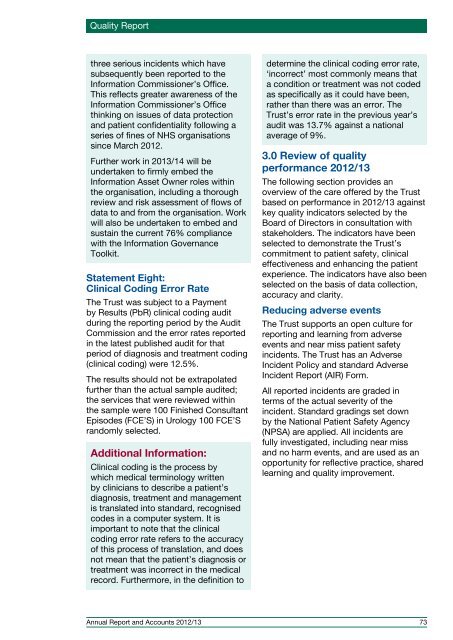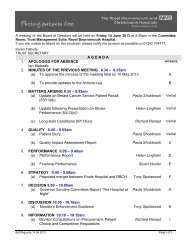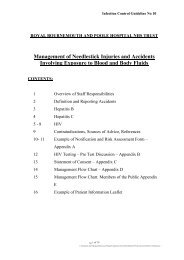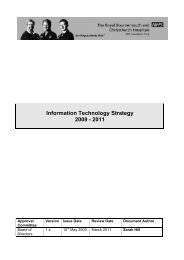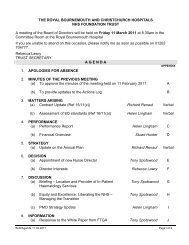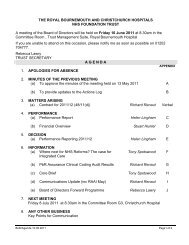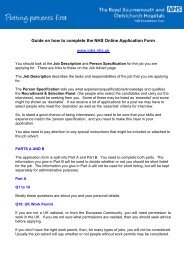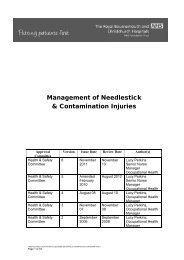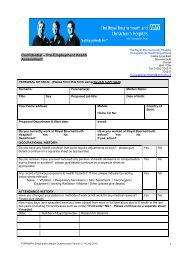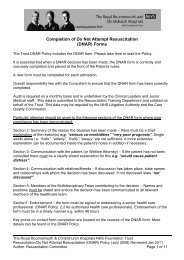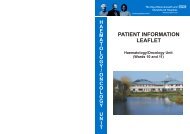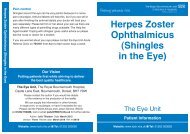Annual Report and Accounts 2012/13 - Royal Bournemouth Hospital
Annual Report and Accounts 2012/13 - Royal Bournemouth Hospital
Annual Report and Accounts 2012/13 - Royal Bournemouth Hospital
- No tags were found...
Create successful ePaper yourself
Turn your PDF publications into a flip-book with our unique Google optimized e-Paper software.
Quality <strong>Report</strong>three serious incidents which havesubsequently been reported to theInformation Commissioner’s Office.This reflects greater awareness of theInformation Commissioner’s Officethinking on issues of data protection<strong>and</strong> patient confidentiality following aseries of fines of NHS organisationssince March <strong>2012</strong>.Further work in 20<strong>13</strong>/14 will beundertaken to firmly embed theInformation Asset Owner roles withinthe organisation, including a thoroughreview <strong>and</strong> risk assessment of flows ofdata to <strong>and</strong> from the organisation. Workwill also be undertaken to embed <strong>and</strong>sustain the current 76% compliancewith the Information GovernanceToolkit.Statement Eight:Clinical Coding Error RateThe Trust was subject to a Paymentby Results (PbR) clinical coding auditduring the reporting period by the AuditCommission <strong>and</strong> the error rates reportedin the latest published audit for thatperiod of diagnosis <strong>and</strong> treatment coding(clinical coding) were 12.5%.The results should not be extrapolatedfurther than the actual sample audited;the services that were reviewed withinthe sample were 100 Finished ConsultantEpisodes (FCE’S) in Urology 100 FCE’Sr<strong>and</strong>omly selected.Additional Information:Clinical coding is the process bywhich medical terminology writtenby clinicians to describe a patient’sdiagnosis, treatment <strong>and</strong> managementis translated into st<strong>and</strong>ard, recognisedcodes in a computer system. It isimportant to note that the clinicalcoding error rate refers to the accuracyof this process of translation, <strong>and</strong> doesnot mean that the patient’s diagnosis ortreatment was incorrect in the medicalrecord. Furthermore, in the definition todetermine the clinical coding error rate,‘incorrect’ most commonly means thata condition or treatment was not codedas specifically as it could have been,rather than there was an error. TheTrust’s error rate in the previous year’saudit was <strong>13</strong>.7% against a nationalaverage of 9%.3.0 Review of qualityperformance <strong>2012</strong>/<strong>13</strong>The following section provides anoverview of the care offered by the Trustbased on performance in <strong>2012</strong>/<strong>13</strong> againstkey quality indicators selected by theBoard of Directors in consultation withstakeholders. The indicators have beenselected to demonstrate the Trust’scommitment to patient safety, clinicaleffectiveness <strong>and</strong> enhancing the patientexperience. The indicators have also beenselected on the basis of data collection,accuracy <strong>and</strong> clarity.Reducing adverse eventsThe Trust supports an open culture forreporting <strong>and</strong> learning from adverseevents <strong>and</strong> near miss patient safetyincidents. The Trust has an AdverseIncident Policy <strong>and</strong> st<strong>and</strong>ard AdverseIncident <strong>Report</strong> (AIR) Form.All reported incidents are graded interms of the actual severity of theincident. St<strong>and</strong>ard gradings set downby the National Patient Safety Agency(NPSA) are applied. All incidents arefully investigated, including near miss<strong>and</strong> no harm events, <strong>and</strong> are used as anopportunity for reflective practice, sharedlearning <strong>and</strong> quality improvement.<strong>Annual</strong> <strong>Report</strong> <strong>and</strong> <strong>Accounts</strong> <strong>2012</strong>/<strong>13</strong> 73


